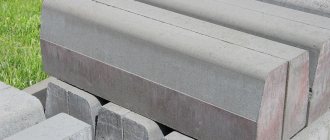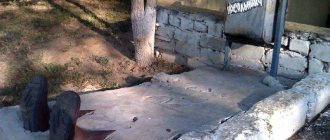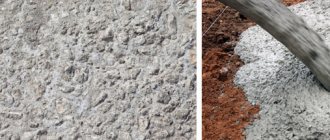Road concrete is used for laying road surfaces and airfield pavements. It stands out as a separate group of concretes. During operation, the material is exposed to various destructive factors: the action of heavy trucks, sudden temperature changes, and precipitation.
The production, quality control and properties of road concrete are regulated by GOST 26633-2012.
GOST requirements
Before using road concrete, you must meet the following requirements to find the right brand:
- Frost resistance . An important factor for Russia, because in many regions the temperature in winter reaches below -15°C, which can lead to a change in the original condition of the roads. To prevent this from happening, the average temperature of the harshest month is calculated, from which conclusions can be drawn about what grade of the top layer of concrete should be.
- Compressive strength . Since the road concrete is constantly under load, the top layer of the road surface changes. In order for the consequences to be minimal, a concrete grade of at least M300 for the base and M400 for the top layer is required.
- Flexural expansion strength . This factor must be taken into account in cases where tension is applied to a horizontal surface. Use grades M5-M50.
- Abrasion . Rolling along roadways can cause depletion of coating layers. The norm of this indicator is calculated using special instruments and compared with the indicators of GOST 13087-81.
- Resistance to chemicals . In the winter season there is often ice. To combat it, chloride salts are used, which should not damage roads.
Execution of work
Let’s look in more detail at what this or that construction stage of road concreting is.
Preparation
Excavation work is difficult, and it is quite expensive. They are preceded by the preparation of a detailed design solution, the conclusions of which are based on geological studies of the area. If there is such a possibility, then concreting roads is done horizontally, removing small hills or placing compacted rock in the depressions.
If a large highway is being built, then the layer of fertile soil is completely removed, and to install a concrete road in the yard, it will be enough to remove fifteen to twenty centimeters of soil.
The prepared base is compacted with rollers and vibration mechanisms, which are heavy.
This stage is considered a crucial moment, since the rigidity indicator and integrity of the road surface depend on the strength of the base, even when the dynamic loads are quite intense.
During excavation work, the installation of a drainage system is considered so that it is possible to remove ground and rain moisture. For this purpose, the base is placed in a plane, the inclined angle of which is from two to four degrees. Concrete gutters are installed on the sides of the road or natural slopes are arranged, along the slopes of which water will flow into receiving wells or go into the ground.
Litter layer
A sand cushion is arranged, the thickness of which is twenty to forty centimeters. This element can be omitted, but it perfectly protects against moisture coming from the ground and improves the drainage process. The bedding layer is necessary to prevent erosion and swelling during frosts, which leads to the formation of depressions and cracks in monolithic concrete.
The most problems appear in clay, peat and other areas of the terrain that can hold water. In most cases, such layers are partially removed, and the bottom is covered with large stones and gravel. The rolled layer reaches a height of thirty centimeters. Such preparation will determine the costs and time required for construction.
The minimum base thickness depends on the type of soil and climatic conditions. It is determined using a special table. If the layer is laid out from different materials, then geotextiles are spread between them.
Level the layers in accordance with the designed slopes. Stone backfills are strengthened with binding materials - cement, granulated slag from metallurgical production, to which quicklime is added, ash from thermal power plants, ground slag.
Formwork
To make this structure, boards are used, the height of which corresponds to the level of pouring concrete for the road. As a rule, it is equal to ten to fifteen centimeters. When determining its dimensions, it is necessary to take into account that ribs are installed along the edges of the concrete to improve strength. The thickness of the boards should not be less than 5 cm. Each structural element must be coated with a special compound that will facilitate detachment from the hardened concrete.
Wooden formwork panels are subject to requirements regarding the level of strength against expansion by fresh concrete mass and the forces that will arise as a result of compaction.
If heavy machinery is used to construct roads made of concrete, which is used to compact the concrete, then formwork made of steel material should be installed. It will last much longer. Each element is based on a sole that improves stability.
The formwork sections are aligned in one line and firmly fixed. This is especially important if the vibration of the concrete mass is carried out by heavy machinery. In places where the level of the base decreases, thin concrete is poured under the formwork to improve stability.
Reinforcement
If the technological process of constructing a concrete road involves this type of work, then the reinforcement should be a metal mesh, the cell area of which reaches 150 mm. sq. This choice of material will make it possible to avoid expansion and the appearance of cracks in the concrete thickness.
The laying of the reinforcing mesh is carried out during the process of pouring the concrete mixture at a height of three to four centimeters from the lower level. Before this, the poured concrete is leveled, a frame mesh is laid, and, if necessary, fixed. Now you can continue working.
Fill
The bedding layer is covered with material that is resistant to getting wet, waterproofing, or simply moistened. Road concrete that complies with GOST is laid out in one thickness at a time. When reinforcement is applied, the process is carried out in stages.
Concrete for the road, the grade of which meets all the requirements, is applied quickly, since it does not have long-term viability. It is not recommended to add water to the mass, because the mechanical properties of the coating will deteriorate. Since the construction volumes are large, factory-prepared road cement is supplied to the work site. The mixture is unloaded one cubic meter at a time and leveled to give the entire layer the same density.
The best option for laying concrete is two or three layers.
The concrete mixture is compacted using special mechanisms, represented by wooden or metal beams, which are impacted by pneumatic hammers attached to them. Such a device is lowered into the mixture and begins to move in it. Having processed one area, the timber is moved further.
If reinforcement is used, the vibration device should be located five to seven centimeters above the top edge of the frame.
In addition to the vibration device, the special machine also has a leveling device located in front.
The concrete composition must be plastic and sufficiently mobile, but not very liquid so that it cannot float, flowing through the formwork panels. All this will negatively affect the strength of the coating.
Seam cutting
A prerequisite is the installation of expansion joints. This type of work is possible when the concrete reaches a certain strength level of 50 - 60 percent. In this form, the canvas is able to withstand the weight of not only the worker, but also a special tool for cutting seams.
In this way, thermal expansion, to which concrete is subject to varying degrees, is compensated. Road segments do not form cracks during seasonal changes.
Sawing is carried out using a jointer - a special tool. The distances between the seams are determined by design calculations. As a rule, to do this, the thickness of the monolithic coating is multiplied by thirty.
To prevent moisture from getting into such seams, they are filled with mastic.
Compound
The composition of road concrete includes the following components:
- water (is a reagent);
- hydrophobic, plasticized Portland cement (binder);
- sand (fine filler);
- basalt/limestone gravel (coarse filler).
The choice of crushed stone should be approached carefully, because the hardness of this component affects the hardness of the entire mixture. The smoother the surface is required, the finer the fraction should be.
GOST 8424–72 is responsible for the correct composition.
Kinds. Classification
The choice of concrete type depends on the purpose of its use and the region with a certain natural environment.
Road concrete is used in three cases:
- For single-layer coating / for the top layer of two-layer coating. The strongest type of concrete is selected, since the lion's share of all loads is borne by the upper part. The required minimum grade according to GOST is M400.
- To create the bottom layer of two-layer roads. The purpose of this layer of concrete is to create a strong base for the top layer.
- Base for strengthening coatings and leveling. The requirements and standards are much lower, because this layer will not be exposed to strong physical activity.
Proportions
The ratio of water to cement according to the purpose of use - table. 3.
Table 3 - Proportions of road concrete components
| Purpose of use | Ratio (water:cement) |
| Single layer/top coat | < 1:2 |
| bottom layer | > 3:5 |
| Strengthening the base | not standardized |
Don't forget about the frost. Depending on the temperature, a certain ratio of water to cement is calculated, which varies between 0.5-0.55.
To create road concrete, a high content of cement (not lower than M400) in the admixture is typical.
The optimal formula for concrete is (in parts – 1:2:5):
- 1 part cement;
- 2 parts sand;
- 5 parts coarse filler.
It is also important to know that using one brand of cement, you can get concrete of different strengths, depending on the proportions of all components.
Examples:
- To get M75 concrete, you need to mix 170 kg of M400 cement , 945 kg of sand, 1053 kg of crushed stone and 210 liters of water.
- And now from the same M400 cement we will get concrete of a different brand - M250. To do this, you need to mix 332 kg of cement, 755 kg of sand, 1080 kg of crushed stone and 210 liters of water.
Laying
Dosage
Laying road concrete.
Granular aggregates are dosed separately each. Cement, aggregates and additives are added by weight. Road concrete is made in a forced-action concrete mixer. After adding all the components, they need to be mixed for about another minute. In order for the coating to be uniform, each layer is poured from only one mixer.
Working with the site
In order to minimize the influence of water, the area under it is raised and the slope is adjusted.
Reconstruction
If the purpose of the work is not to lay a new route, but to apply concrete to an existing road surface, the task is greatly simplified, since there is no need to wait for the concrete to be compacted. The work area is cleared. The area is leveled so that there are no bumps or holes. The area is covered with coarse sand (30-50 mm), and then with the same layer of crushed stone. They make formwork. There is no need to fill the entire area with concrete at once. Gaps must be left at short distances.
Samples
Before you start laying the mortar, you need to check the constituent materials. This is done in order to check whether certain additives will give the necessary qualities to the material. The result of the study must be recorded in the protocol for each parameter separately. Such a document is part of the construction contract.
If the construction of another facility is carried out in the same area and environmental conditions, it is allowed to use previous data, but they should not be older than 24 months. Samples may be requested by the customer. If materials are supplied from production, factory quality control is also required.
Production technology
Road slabs are created from concrete using two methods: aggregate-flow, bench-type.
The aggregate-flow method is characterized by the speed of production of slabs, but there are several different types of stages. Each of them has its own time interval, because different volumes of concrete require different amounts of hardening time. The shape of the plates is different. The movement of products is carried out by flow through transport mechanisms. Drying takes place in designated chambers. To connect the slabs, horizontal loops are placed in the concrete molds.
The bench production method differs in the way the plates are moved. If in the aggregate-flow method products are moved through special equipment from one processing stage to another, then in the bench method the movement is minimized. Moreover, the product itself remains motionless in the stand. Only the position of the thematic units changes. The slabs are mainly made of the same type and size. The product is positioned differently on the stand: vertically, horizontally, singly or in groups, etc.
The next step is to remove the slabs using special installations that hook them into the grooves. Next, the travel goods are placed on carts and taken to warehouses, where they are slung.
An important step is to check the strength of the resulting product. After testing, there should be no cracks left on the product. Otherwise, the product is unusable.
All stages must comply with GOST, SNiP, TU standards.
In addition to road slabs, the route is filled with concrete mixture mixed at the factory. The concrete road has its structure in the form of 3 layers:
- Underlying.
- Strengthening.
- Roadbed.
All layers are different in density, ratio of components, etc.
Advantages and disadvantages of concrete road slabs
For several centuries, concrete has been actively used in most construction work. Until now, no material has been invented that would be better in terms of its total characteristics. And, despite the fact that asphalt is more often used in road work, concrete also has a number of advantages.
Advantages of concrete slabs
Durability
Concrete is a very durable material that practically does not change its structure under the influence of various loads. Therefore, passenger vehicles, heavy tracked vehicles, and even airplanes can move on such a surface.
In comparison, asphalt is more prone to deformation, creep and rutting. For example, if temperatures are too low, the fabric may become cracked. In hot summer weather, asphalt can melt and be pressed under the weight of cars.
The service life of an asphalt road does not exceed 20-25 years. Concrete retains its characteristics much longer. Nowadays you can find roads made of concrete slabs, built back in the 70-80s of the last century. They are still in good condition and actively used.
Simple installation technology
Concrete slabs are laid on compacted soil with a sand cushion. To create such a coating, no complex equipment is required - a regular truck crane and grader are enough. Immediately after laying, the road is ready for use.
But with asphalt, for example, everything is much more complicated. Firstly, it requires the construction of a multi-level base consisting of sand, crushed stone, geogrid and several layers of asphalt concrete. Secondly, you need a lot of equipment, including excavators, bulldozers, soil cutters, asphalt pavers, rollers or vibrating plates.
Possibility of installing coatings in any conditions
Fresh asphalt begins to harden immediately after preparing the mixture. There is very little time left for installation. Therefore, for the construction of asphalt roads, it is necessary that there is an asphalt concrete plant nearby from which the raw materials will be supplied. It is also necessary to correctly calculate the delivery schedule - so that each batch is packed immediately after delivery to the site. In addition, such work is not carried out at all in winter.
As for concrete, it also tends to set quickly. However, the slabs are produced in factories and arrive at the site in finished form. All that remains is to lay them down. This can be done in any weather. At the same time, it is not at all necessary that the enterprise producing the slabs be located next to the road under construction. Therefore, concrete slab coatings can be found even in the most remote corners of our country.
Relatively low cost
On average, the price of a road slab starts from 10,000 rubles per piece. This is approximately 4.5 square meters of coverage. A similar volume of asphalt can be purchased cheaper. But do not forget that laying an asphalt concrete road uses more complex technology and requires more equipment. Therefore, in the long run, concrete slabs are cheaper.
Reusability
Temporary roads and driveways are often built from concrete slabs. In the future, such coatings can be dismantled quite easily, and the slabs themselves will be suitable for use for other purposes.
Asphalt, by the way, is also reused. For example, during road repairs, the top layer of the road surface, called asphalt cutting, is removed. This material can be used for filling small potholes, as well as for constructing various platforms and parking lots in garden plots. However, the strength of used asphalt cannot be compared with concrete slabs.
Disadvantages of concrete slabs
Impossibility of creating a monolithic coating
No matter how tightly the concrete slabs are laid, there will still be cavities between them. Such “seams” increase road noise when vehicles pass along them. In addition, grass grows in the cracks between the slabs, which deteriorates the appearance of the coating.
This can be avoided by covering the joints with concrete mixture. However, it is worth clarifying that over time these joints will crack due to the “walking” of the slabs. On the other hand, if we are talking about temporary roads or industrial sites, then the presence of cracks is not a problem at all.
More complex repairs
To repair a damaged area of asphalt, simply remove the top layer of coating around the perimeter of the pothole and then lay new asphalt there. With concrete it is much more difficult: if it cracks, then in most cases you have to replace the entire slab. And this is more expensive than pothole repair. But note that concrete coatings last much longer - up to 50 years or more.
Our own concrete production and laboratory, as well as a large fleet of equipment guarantee high quality products and accurate delivery times
Concrete - production and delivery
Concrete pumps - rent
Read more about us here
7 904 179–31–56
Valentin Yurievich Shvets
Director of BetonStroy
Areas and features of application
Road concrete is used in the construction of highways, roads in cities, road surfaces for air transport, all kinds of pedestrian paths, sidewalks, hydraulic engineering and bridge structures, basement floors of massive buildings, subways, and dams.
It must be remembered that concrete should be selected based on density based on individual terrain characteristics according to the above criteria. The service life of correctly selected concrete will be longer than that which was chosen at random.
Information sources:
- [url] GOST 8424–72
- [url] GOST 13087-81
Requirements for road concrete
Often the road surface is subject to extreme operating conditions, therefore special requirements are imposed on road concrete:
- Compressive tensile and bending strength. Trucks and trucks constantly travel along highways; the road surface should not be destroyed under their weight.
- Abrasion. With a continuous flow of cars, the road surface gradually loses its thickness. Abrasion greatly affects the service life of the road surface: the higher it is, the less durable the coating will be.
- Water resistance. The strength of concrete may decrease due to the Rebinder effect. Water penetrates even small microcracks; when it freezes, it expands, thereby enlarging the cracks.
- High frost resistance. In winter, temperatures throughout almost the entire territory of Russia are negative, but the road surface should not melt along with the snow.
- Resistance to aggressive chemical environments. During icy conditions, roads are sprinkled with reagents, so the coatings should not be destroyed under their influence.










